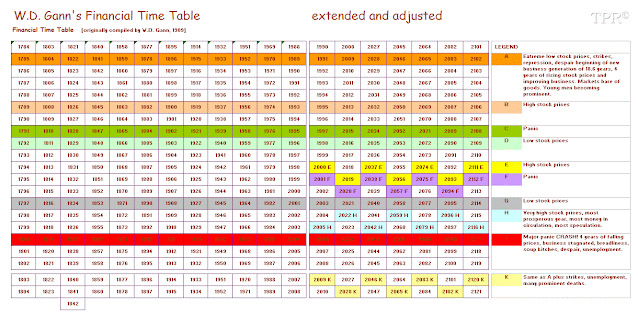W.D. Gann’s Financial Time Table from 1784 to 2008 is based on the 18.612958-year
lunar nodal cycle (6,798.383 days, the time for the Moon's north node, also referred to as the True Node, to complete one
orbit relative to the ecliptic). Compiling his Financial Time Table in 1909, however, Gann approximated the lunar node's period without an ephemeris by simply alternating 18- and 19-year intervals to achieve an average of 18.5 years—an error of 47.33 days per cycle, meaning Gann's cycle is lagging behind the node's true position.
Fast-forward to late 2025, Gann's error sums up to 300 days. Hence,
the exact criteria and starting date to which he anchored his cycle,
including his annotation: "Dec. 25, 1989 revises to Mar.
13, 1934," remain unclear and subjects of debate. The table’s basic conceptual congruence with Louise McWhirter's 1937 "Theory of Stock Market Forecasting" led analysts to suspect "Louise McWhirter" was merely a Gann alias used to correct the flawed astronomy of his 1909 Time Table and provide an elaborated astrological theory of the lunar node's 18.6-year cycle and its impact on the US business cycle and stock market.
Regardless, even though the extended version of the original table into 2121 did not correct Gann's error, it forecasted a market panic in 2020 (accurate), and high stock prices in 2022–2023 (accurate?). For 2024, 2025, and 2026, Gann's table warns about a "major panic CRASH! 4 years of falling prices, business stagnated, breadlines, soup kitchens, despair, unemployment." Correct? For 2027 to 2031, the table announces "extreme low stock prices, strikes, repression, [and] despair" to be followed by the "beginning of [a] new business generation of 18.6 years. 4 years of rising stock prices and improving business. Markets bare of goods. Young men becoming prominent." Time will tell.
» Major crash in 2024–2026
with prolonged economic stagnation, and a recovery by 2028–2030. «
W.D. Gann's original "Financial Time Table" adjusted and extended into 2121.
While appealing, the table’s predictions
should be approached cautiously, considering external factors and the
debated accuracy of Gann’s methods.
» Maybe Gann’s table should be shifted for a few months in view of 18.5M approximation vs 18.6M desired value. «
Branimir Vojcic is right: For higher degrees of conviction, diehard Gann aficionados may want to re-anchor the exact lunar nodal period to a specific date (e.g., sign ingress, natal chart, crash low), and derive further clues from "Louise McWhirter."
See also:






















%20-%20Forecasting%20the%20NYSE.gif)




















